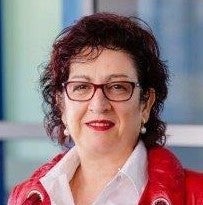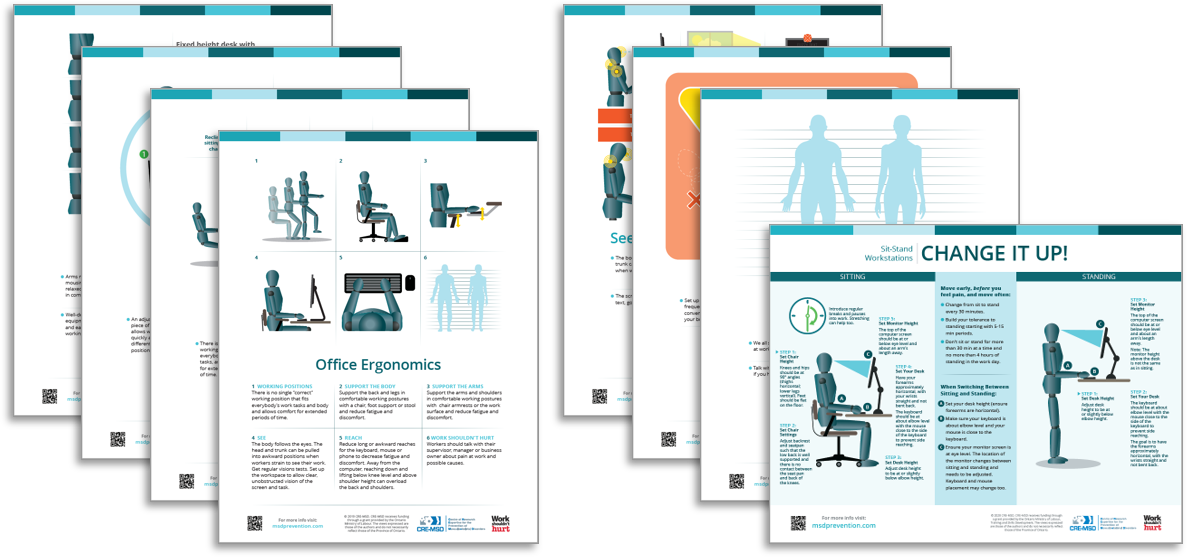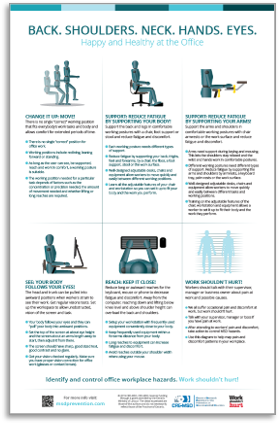Webinar series
The COVID-19 pandemic has forced a rapid change in the way we work and the need to support workers at the office and at home. Adjustments have been made including work hours, equipment, physical space layout and work format, be it virtual or masked in-person. The temporary remote work instituted in March of 2020 resulted in using makeshift workstations at kitchen counters, spare bedrooms, and living rooms, a situation that continues for many to persist over 1.5 years later.
Join CRE-MSD, IHSA, PSHSA, WSPS, and OHCOW during Global Ergonomics Month in October for this free webinar series featuring six international experts. The series will explore flexible/hybrid office environments and returning to on-site office workspaces, how these can be supported, the impact on health, moving beyond the constraints of individual productivity, and a look at what a true “virtual” workspace will look like in the future.
This five-part webinar series will examine research on how pivoting imposed by COVID-19 health hazards has impacted workers and challenged the health and safety support system’s ability to ensure ‘work shouldn’t hurt’. It will assist organizations to learn about and help prevent physical, cognitive and psychological challenges related to remote work practices implemented during COVID-19.
Other webinars in the series
Expanding the Bounds of Seated Virtual Workspaces
In this webinar
The office work environment is changing. These changes challenge what, and how health and safety information is delivered. This webinar will present results of several studies that investigated the physical and psychosocial risk factors for physical health in office workers in a traditional office environment and while working from home during the pandemic. This will be followed by a discussion of interventions to prevent and reduce the risk of discomfort experienced for those using a traditional office workstation and those transitioning to height adjustable workstations.
For assistance, please contact Betina Butler at bbutler@uwaterloo.ca.
About the presenter

Dr. Venerina Johnston is an Honorary Associate Professor at The University of Queensland and Director of The Good Work Lab. Venerina is a clinician with post-graduate qualifications in occupational health and safety and work disability prevention. She has extensive industry experience and research academic expertise accumulated from 30 years working in various roles and industries including manufacturing, mining, local government, health and education sectors and workers’ compensation and compulsory third-party insurers. Her research adopts a multi-disciplinary approach to design and implement workplace-based interventions to reduce the overall burden of musculoskeletal problems on the individual, employer and society.
Other resources
We encourage you to take advantage of CRE-MSD resources such as the Office Quick Start Guideline, a collection of posters/infographics that provide basic information and quick workplace fixes for preventing MSD while performing office work. This free resource is part of the MSD Prevention Guideline for Ontario.



Disclaimer: CRE-MSD receives funding through a grant provided by the Ontario Ministry of Labour, Training and Skills Development (MLTSD). The views expressed are those of the presenters and do not necessarily reflect those of the Centre nor of the Province of Ontario.